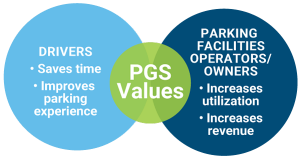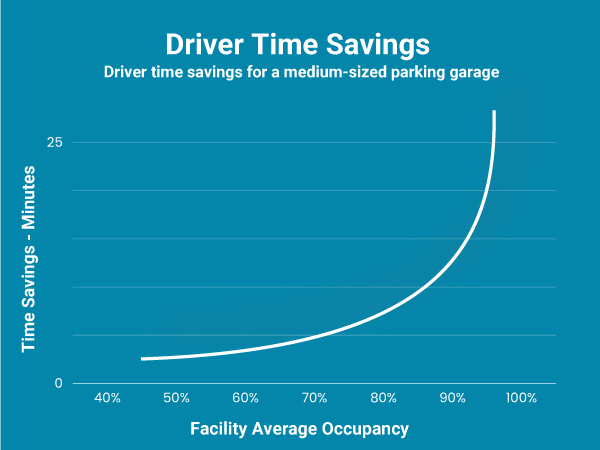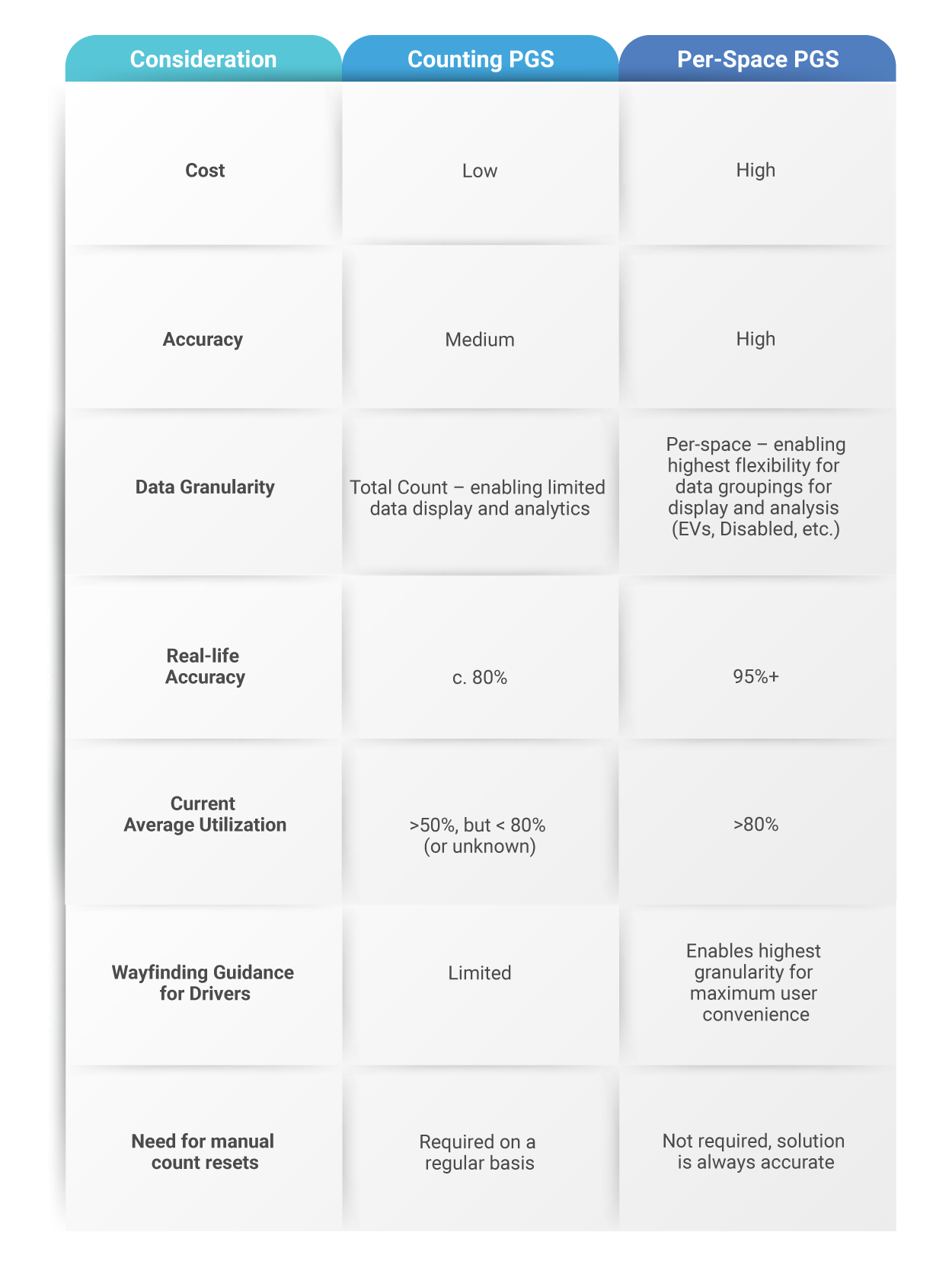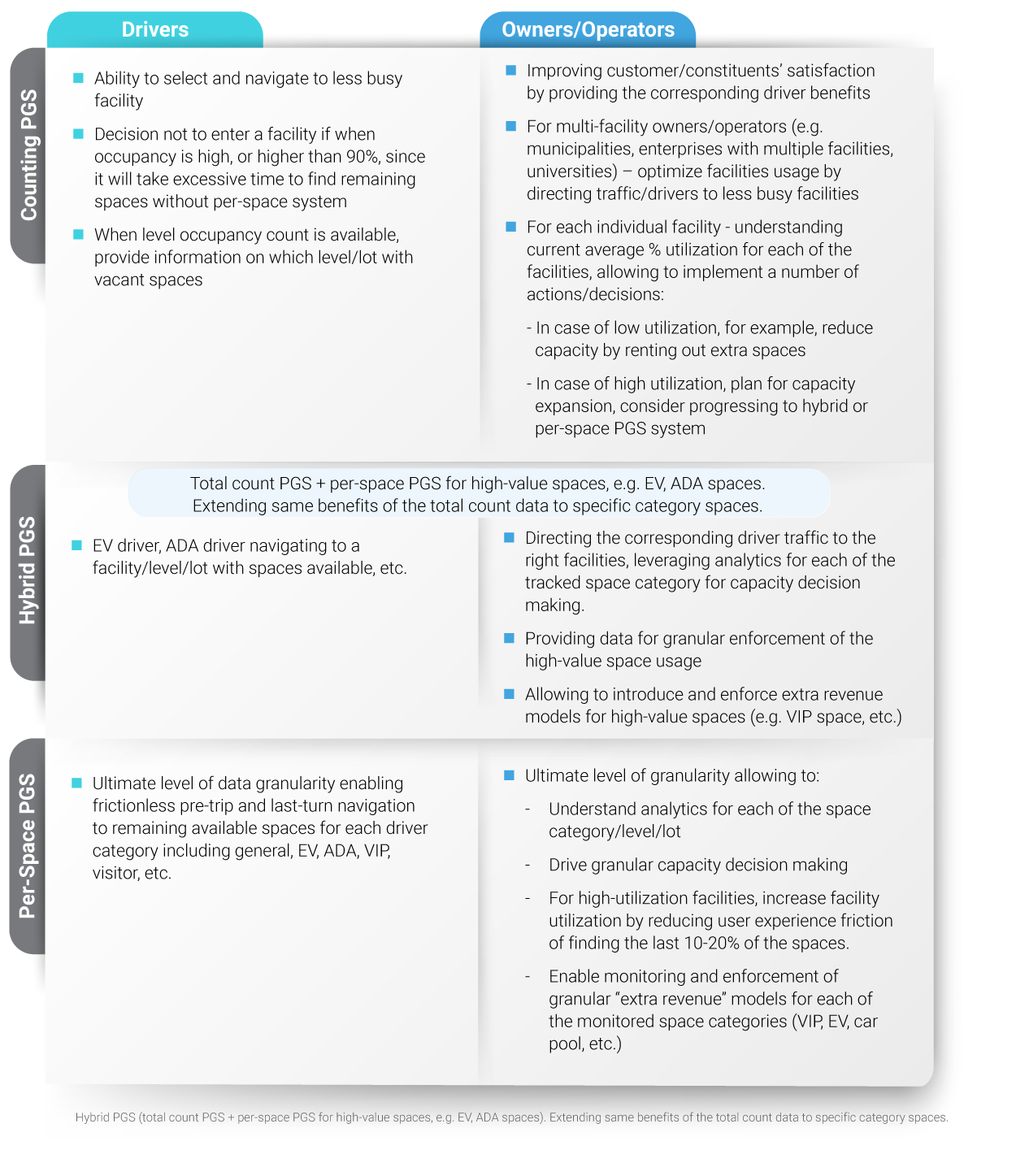
A Parking Guidance Solution for every Parking Facility
A Smart Parking Guidance System (PGS) is a parking system that, in real-time, directs drivers to available parking. Two main functions of a PGS system are:

The smart parking system provides real-time data on the availability of parking spaces and helps the driver park quickly and efficiently. PGS technology addresses the long-term issue of parking and pollution, which harm the environment. Sensors, real-time data, and smart mobile applications allow users to monitor available parking and reduce the time spent finding a parking space.
PGS Solution Types
PGS solutions can be grouped based on the method of vehicle detection. This choice drives all the main features and characteristics of a particular PGS including its accuracy, cost, level of user experience, and more.
Different solutions can be structured into several types based on these main characteristics:
- Vehicle counting vs. per-space detection
- Camera image analysis vs. direct vehicle sensing for vehicle detection
- Wired vs. wireless
PGS Selection
Considerations for choosing the right solution:
- Facility characteristics (e.g. entrance and exit lanes characteristics, new vs. retrofit, ceiling heights, etc.)
- Usage patterns
- Utilization levels
- Accuracy requirements
- Data granularity requirements
- Driver convenience goals
- Budget
Choosing your PGS solution: Counting vs. Per-Space, Hybrid Solutions
Selecting between these various solutions is typically driven by these several factors:
- Average facility utilization
- Target accuracy level
- Presence of high value/special categories spaces
- Facility complexity and drivers’ preferences
Average Facility Utilization
Current average utilization is a good initial, and the most important, factor driving a PGS solution selection for a particular facility.
If the facility is, on average, 40-50% utilized, a PGS would offer limited value, since a driver can easily find available space w/o any PGS in place. Still, in such situation a different question arises – why the facility is underutilized and whether scaling down the available number of spaces via e.g. sub-leasing is an appropriate course of action. At the same time, a facility that averages 90% occupancy will experience high value from helping drivers locate parking faster and help the facility fill the last 10% vacancy for full occupancy.
While specific time saved by a per-space PGS depends on a wide range of parameters, including the facility’s characteristics, driver behavior, etc., in general, it grows exponentially as a facility fills up. Thus, as a rule, the higher the level of the current average utilization of the facility, the higher the value a PGS can generate for it.
Below is a graph demonstrating a correlation between the facility’s current average utilization and estimated driver time savings for a typical medium-sized parking garage. For example, at 60% occupancy, a per-space PGS solution would save an average of 1 minute of searching time per driver, at 80% – 5 minutes, and at 99% – 15+ minutes on average, reaching 30+ minutes when drivers must leave the facility in search of parking elsewhere.
 In situations of medium utilization, a car-counting PGS can be a good initial solution. Vehicle counter systems are installed at the entrance and exit from an enclosed parking lot or a garage structure and count the number of vehicles entering and leaving the facility. Vehicle counting is an excellent way to measure the overall level of parking activity and approximate lot utilization and overall usage statistics.
In situations of medium utilization, a car-counting PGS can be a good initial solution. Vehicle counter systems are installed at the entrance and exit from an enclosed parking lot or a garage structure and count the number of vehicles entering and leaving the facility. Vehicle counting is an excellent way to measure the overall level of parking activity and approximate lot utilization and overall usage statistics.
For a vehicle counter to be a viable solution, the parking lot must be enclosed with defined and relatively narrow entrances and exits. Such a solution is inappropriate for municipal on-street parking and will work less for parking lots with multiple and wide entrances/exits.
Target accuracy level
An important consideration of counting solutions is “error accumulation”. While no vehicle detection and counting hardware is 100% accurate, best-in-class counting technology provides 98%-99% accuracy. And unlike per-space solutions, where this error is automatically resets every time a parking space is occupied or vacated for overall solution accuracy, such detection error accumulate in a counting solution until it is manually reset. When 1 to 2% errors build up with each counting detection event, in 10 days, the accumulated error can exceed 10%. The only way to minimize this problem is regular manual counting and adjustment or reset of the counting solution. However, there are human errors and factors, too: you cannot always be sure that a manual reset is 100% accurate.
Due to the nature and limitations of the counting solution, it is typically most appropriate when “order of magnitude” occupancy numbers for a facility (e.g. 40% vs. 60% vs. 90%) are sufficient. As summarized below, such data can still provide significant value to both drivers and facility owners. On the other end of the spectrum, per-space solution delivery always accurate and most granular actionable data for both drivers and facility owners.
Presence of high-value spaces
In addition to regular parking spaces, most facilities today have a limited number of special category spaces designated, such as EV, disabled, reserved, etc. Obviously, the availability of these spaces is a much more important factor for these category drivers than the total spaces available in the facility. Thus, the same “average occupancy” concept can be applied not only to the total spaces but to each of these categories to determine an optimal PGS solution for these drivers.
For example, let’s take a facility that is, on average, only 60% occupied, so a total count of PGS seems to be the right answer here. However, let’s also say that 20 EV spaces are, on average, 90% occupied. It follows that for the EV drivers using this facility, these spaces are high-utilization spaces and they will benefit significantly from having granular occupancy data about these spaces. In such situations, a counting PGS system can be complemented by per-space sensors for these high-value spaces, making it a so-called “hybrid” PGS solution. Having granular data for these high-value spaces would provide the facility owner/management with the analytical insights needed to make decisions about the corresponding capacity changes.
If a facility has a large percentage of the high-value spaces, e.g. > 50% of total spaces, from the cost-value and accuracy point of view, it starts making sense to consider a full-per-space PGS system.
Facility complexity and driver preferences
Let’s again take an example of a facility with 60% average utilization. But, this facility had a complex driving pattern resulting in highly-used areas next to most logical driving patterns and underused “pockets” where fewer drivers venture out. For this situation, a typical driver would experience more difficulties in finding a free space, effectively making it a higher-utilization facility for a typical driver.
Let’s also consider human behavior and driver preferences. In general, people prefer to park in “higher convenience” zones, e.g. next to the exit/elevators, etc. and, in general, prefer to park in the lower (first to drive in) levels of the facility and, in particular, try to avoid parking on the roof/open levels. Such preferences tend to lead to higher occupancy for certain areas/levels of a facility vs the theoretical “average” occupancy for this facility, increasing the perceived occupancy for an average driver and, thus, increasing the benefits of a more granular PGS system.
While thinking about counting vs. per-space PGS selection, it is important to note that, in principal, it does not have be one or the other. A counting solution can be viewed as “starter” PGS solution that can be expanded and grow with time to a “hybrid” PGS and a full per-space solution if required.
Tables below summarize some of the most important considerations driving an initial PGS selection between counting and per-space approach for a particular facility, with a “hybrid” solution potentially offering a balanced approach for many typical facilities.
Selecting between Counting and Per-Space PGS

Counting vs. Hybrid vs. Per-Space PGS: Driver and Facility Owner/Operator Benefits


